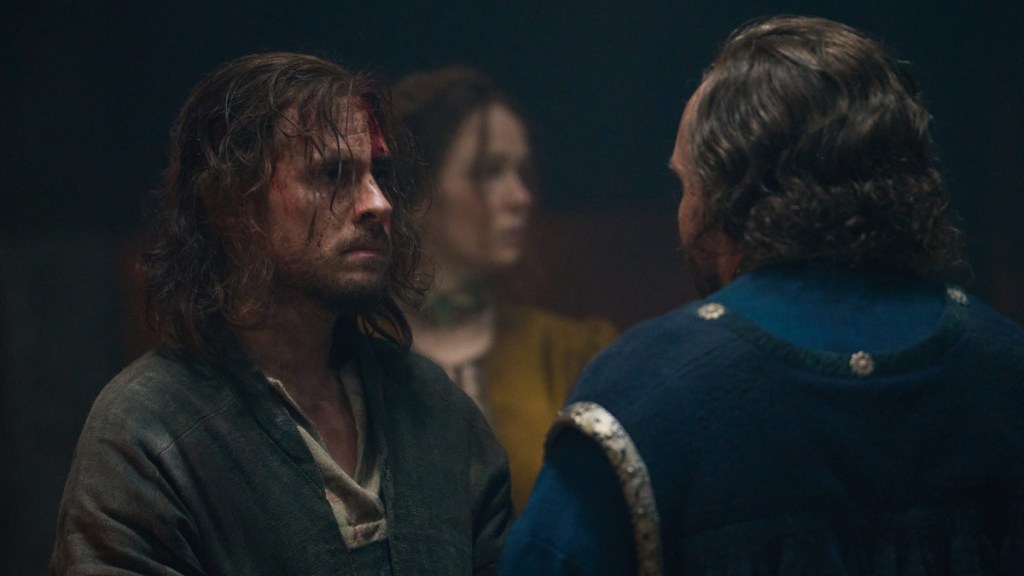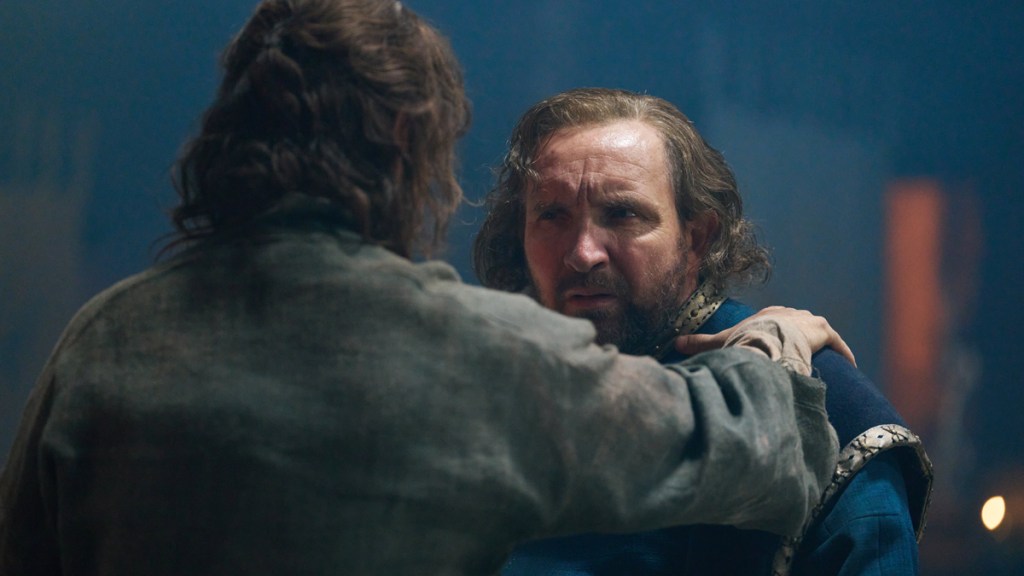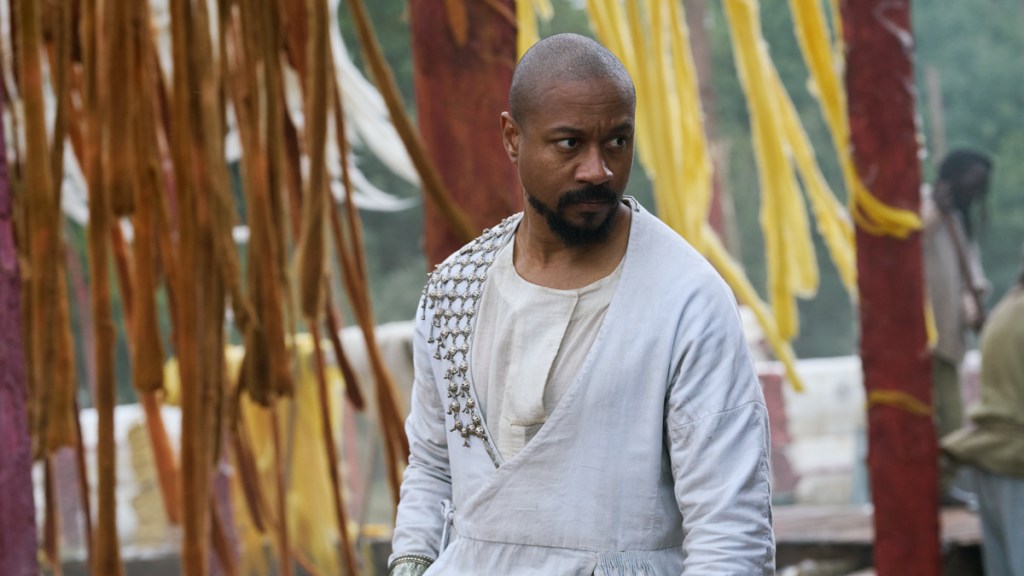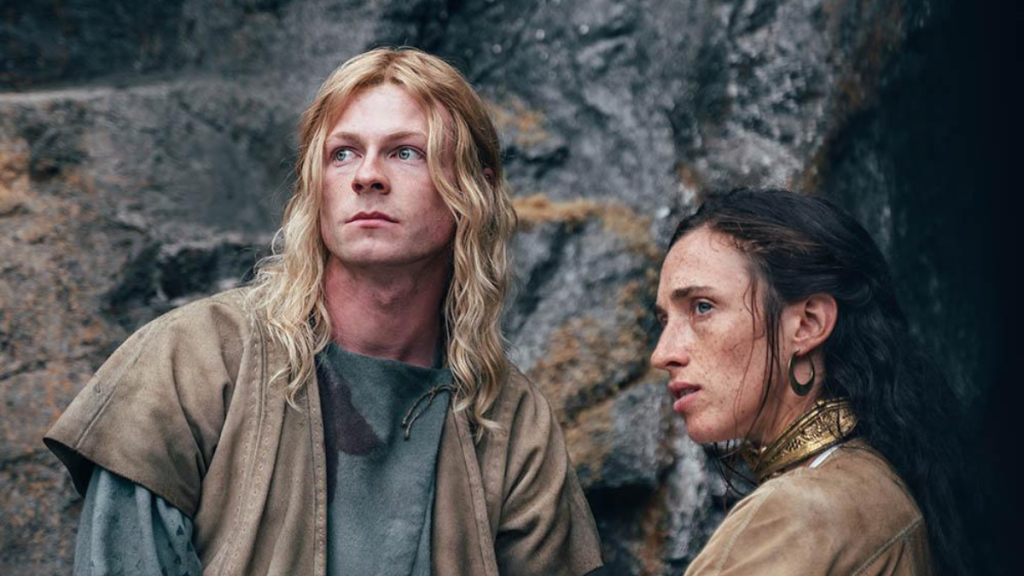The Winter King: How Historically Accurate is the King Arthur Series?
We untangle the myth from the fact in The Winter King, based on Bernard Cornwell’s Warlord Chronicles.

MGM+’s new series about King Arthur, The Winter King, is based on a trilogy of novels by well known historical novelist Bernard Cornwell, author of the Sharpe books. Cornwell’s historical fiction is always well-researched. But just how “historical” is King Arthur in the first place?
People have been telling stories about King Arthur for centuries, but historians aren’t even sure if anyone by that name ever existed. Even the earliest stories were told centuries after Arthur would have lived, if he were real. On top of that, of course, there are quite a few elements of those stories that seem… unlikely. Women sticking their hands out of lakes holding swords, that sort of thing. Some dragons. But there are elements of truth to some of the stories, and the historical setting of them is real enough.
The Setting: Post-Roman Rule Political Chaos
Stories about King Arthur usually take place in what is now England and Wales, some time during the fifth century CE. Arthur is not an English king – in fact, he is known for fighting the invasions of the Anglo-Saxons, the people who would later become known as the English. Arthur, if he existed, would have been some combination of Roman and Brittonic, also known as Brythonic. Brittonic Celts are the ancestors of the modern Welsh, Cornish, and Breton peoples, who are more distantly related to other Celtic inhabitants of the British Isles like the Scots, Picts, and Irish Celts, as well as the Gauls in France. Arthur is the King of the Britons, the descendants of indigenous Celtic people of the British Isles and of the Romans who had occupied the area for 400 years.
To give a bit of context, the southern part of Britannia had been part of the Roman Empire from 43 CE when it was invaded under the Emperor Claudius (Julius Caesar invaded twice but didn’t bother staying) until 410 CE. The Romans occupied various bits of southern Scotland at various times but most of Scotland was not conquered and they never tried to take Ireland. In 410, the Romano-British supposedly wrote to the Roman Emperor Honorius asking for help against invasions from Saxons, Angles, Jutes and others from the continent, but Honorius wrote back and told them to look after themselves. We can safely assume they stopped paying taxes or following Roman laws after that, but there were of course many people from all over the Roman Empire, from Gaul to North Africa to the Middle East, living in Britain still.

This is the basic setting for the stories of King Arthur. Southern Britain is no longer under Roman rule, and the political situation is chaotic, with lots of warring tribes and small kingdoms. The area is under constant attack from the continent, particularly from Saxon invaders. The Romano-British and British Celts were slowly driven more and more towards the west – Wales and Cornwall – by the invasions from the east.
There was an historical battle between the Britons and the Anglo-Saxons around the end of the fifth century, the Battle of Badon Hill. Gildas, a sixth-century British monk and historian, says it was one of the last major victories of the British against the Saxons. He also mentions a Roman leader of the British called Ambrosius Aurelianus. A later historian, William of Malmesbury, calls Ambrosius the last of the Romans and says he was King of the British and that Arthur fought for him, but Gildas makes no mention of Arthur.
Tribes and Kingdoms: Dumnonia, Siluria, and Arthur’s Anglo-Saxon Enemies
Before the Roman invasion, Britain was ruled by many different kings and queens of different tribes ruling different areas. These tribes were often at war with each other, and some allied with the Romans, while others – most famously Queen Boudicca of the Iceni in south-eastern Britain – fought against them.
When the Romans left, they left a power vacuum behind them, and southern and western Britain once again split into lots of small kingdoms that were often at war with each other. A major theme in stories about King Arthur is that he unites various British kingdoms together to fight the invading Saxons. The Anglo-Saxon kingdoms in the east were broken up into several small kingdoms at this time as well – no one called themselves “King of the Anglo-Saxons” until Alfred the Great in 886.
The setting for much of The Winter King is the kingdom of Dumnonia, one of the biggest kingdoms, in what is now Cornwall. The Dumnonii were the Celtic British tribe who had been living there since before the Roman invasions. The kingdom may have been made up of smaller sub-kingdoms or client kingdoms with one overall King. This is how it is represented in Cornwell’s books. We are not certain exactly where the King of Dumnonia was based, but Cornwell invented the site of Caer Cadarn to be the royal seat of the kingdom, placing it right on the eastern edge of Dumnonian territory, and he made the King of Dumnonia High King of all the Britons.

Cornwell’s books also refer to a kingdom in south Wales called Siluria. In real life, in the 5th century this was three kingdoms called Gwent, Brycheiniog, and Gwynllŵg, all of which were inhabited by Silurians. Not, as Doctor Who fans might expect, lizard people from the dawn of time, but a Celtic tribe called the Silures, who were thought to have come to Britain from Spain centuries earlier, because their hair was curly and their skin was darker than other British tribes. Cornwell collapses two of the Silurian kingdoms, Brycheiniog, and Gwynllŵg, into one (possibly to avoid having to spell them) and separates them from Gwent.
Cornwell also re-names the historic Welsh kingdom of Dyfed as Demetia after its inhabitants, the Demetae tribe, and he puts together the Welsh kingdoms of Ceredigion and Powys into one (Powys). The northernmost Welsh kingdom of Gwynedd (pronounced “Gwy-neth”) also comes into the story. The areas controlled by the Anglo-Saxons were also divided up into lots of smaller kingdoms and territories but Cornwell collapses quite a few of these into each other, which makes sense considering the medieval texts which tell stories of Arthur usually group all his Anglo-Saxon enemies together anyway.
The Stories: Merlin, Excalibur, Avalon and the Round Table
The name “Arthur” may come from the Roman name Artorius, or from the Welsh “arth gwyr”, meaning “bear man”. The earliest reference to a British warrior called Arthur is in the Old Welsh poem Y Gododdin, written to commemorate Welsh soldiers who died at a battle in Yorkshire around 600. One soldier is described as powerful, but “he was no Arthur” – a bit of a mean eulogy, really. The earliest references to a Briton called Arthur fighting the Saxons appear in the History of the Britons by Nennius, a cleric writing in Gwynedd around the year 830 who says Arthur was a Christian warlord who led a group of British kings against the Anglo-Saxons.
The two most important historians who wrote about Arthur were William of Malmesbury and Geoffrey of Monmouth, both in the early 12th century. William’s The Deeds of the English Kings says Arthur is fondly remembered with many fables, and that he roused the British against the Angles and won a great victory at Mount Badon. Geoffrey’s stories of Arthur are better known, though, because it was Geoffrey’s History of the Kings of Britain and his Life of Merlin that introduced lots of familiar elements of Arthurian legend, including Merlin himself. William’s reference to popular fables suggests these were stories that had been circulating orally before that, but it was Geoffrey who first wrote about Merlin, Excalibur (called Caliburn), Arthur’s death on Salisbury plain and his burial at Avalon.

In The Winter King, Avalon is placed at the site of modern Glastonbury, following the idea that the mysterious island is actually the inland hill of Glastonbury Tor. Later in the 12th century, a Norman poet called Wace added the idea that Arthur had a round table for his barons so that they could not argue about status at meetings.
After William and Geoffrey, we start to see numerous poems and stories about King Arthur appear. Some of the most famous are Thomas Malory’s Le Morte d’Arthur, the works of Chrétien de Troyes, and the anonymous poem Sir Gawain and the Green Knight. Chrétien de Troyes lived in northern France and wrote several poems in Old French about Arthurian legends, including stories about Lancelot and Guinevere, and about the search for the Holy Grail. Sir Gawain and the Green Knight was written in Middle English about 1400, and is now best known for having been translated by JRR Tolkien. Le Morte d’Arthur is one of the most famous of all. It was written in Middle English prose in the 15th century, most likely when its author was in prison for assault, theft, rape, and attempted murder, which might explain a lot about some of its darker themes.
Arthur’s Parentage: Illegitimacy, Uther and Mordred
Ever since Geoffrey of Monmouth, a key part of Arthur’s story has been that he was illegitimate. According to Geoffrey, the King of Britain, Uther Pendragon, fell in love with Igraine (or Igerna), the wife of Gorlois, leader of Cornwall (Kernow) who was based at Tintagel on the coast of Dumnonia. So Merlin gave Uther a potion that made him look like Gorlois so he could trick Igraine into sleeping with him, and that is how Arthur was conceived. Although Uther later married Igraine after Gorlois died, Arthur had already been born, making him illegitimate in this version of the story. In Malory’s version in Le Morte d’Arthur, however, the nameless Duke of Tintagel dies the same night Uther sleeps with Igraine, so Uther is able to marry her sooner and Arthur is legitimate, probably reflecting the important of legitimacy to inheritance when Malory was writing.
Geoffrey of Monmouth says 15-year-old Arthur was crowned king by hereditary right anyway, but later authors presumably thought the succession would not be that straightforward if Arthur was not Uther’s legitimate heir. This is why we get the story of the sword in the stone, with whoever pulls the sword from the stone being Uther’s rightful successor, which is first told in a late 12th century French poem Merlin, by Robert de Boron.

Arthur also has a number of half-siblings, nephews, and sometimes a son. The exact number, their names, their ages, and their exact relationship to Arthur tend to vary a lot between different versions of the story. In Malory’s version, Arthur has three sisters, all the children of Igraine and her first husband, the Duke of Tintagel. The younger two are the witch Morgan le Fay and Elaine, who doesn’t do very much. The oldest is Morgause, who is married to a King Lot, an enemy of Arthur. Morgause, spying on Arthur for her husband, sleeps with Arthur without either of them realising they are brother and sister, and conceives Mordred, who is therefore both Arthur’s nephew and his illegitimate son.
Malory seems to have introduced the incest idea, but Mordred is usually Arthur’s nephew, foster-son, son, or some combination of those three. More consistently, from Geoffrey of Monmouth onwards, Mordred rebels against Arthur and both are killed in the final battle between their armies.
The Winter King plays around with the family relationships a little, but keeps them fairly similar to the most popular traditions. In this version, Uther looks down on Arthur for being illegitimate and calls him the “son of a whore”, which suggests a slightly different backstory, as traditionally even Uther did not blame Igraine for sleeping with him when she thought her was her husband. Cornwell’s book did follow tradition in making baby Mordred Arthur’s nephew, the son of another Mordred, a legitimate son of Uther killed at the beginning of the story. In the TV version, however, there is a time jump between the death of the older Mordred and the birth of baby Mordred, who is in this version Uther’s legitimate son himself, making him Arthur’s half-brother, though the age difference keeps Arthur’s role as his relative and protector the same. We also meet Arthur’s half-sister Morgan, but instead of being the legitimate daughter of Arthur’s mother Igraine and her first husband, in this version Morgan is another illegitimate child of Uther.
Merlin, Nimue , and Morgan
One or two major characters from Arthurian legend were left out of Cornwell’s version in The Winter King, most notably the tyrannical British King Vortigern, who is often an early enemy. Most of the main players are here, though, or will turn up later. Early episodes introduce us to three especially important and often mysterious characters; Merlin, Nimue, and Morgan.
Merlin, or Myrddin (pronounced “Mir-thin” and not, as Stargate SG-1 put it, “Mir-dan”) is a prophet and a magician who first shows up in Geoffrey of Monmouth. Geoffrey seems to have conflated the Welsh Myrddin with the role Ambrosius (the last Roman) plays in Nennius as a young advisor to Vortigern, and then he added quite a bit more material. The early 13th century French poem Merlin, by Robert de Boron, made Merlin more explicitly Christian (as well as adding the story of the sword in the stone). Some 20th century scholars thought that, if there was a historical Merlin, he might have been a Druid and an advisor to kings, a bit like a shaman. That is more or less the way he is depicted in The Winter King, except that he also rules over his own area of Avalon.

Nimue is the Lady of the Lake, sometimes called Ninian or Vivienne. She appears in French romances from the 13th century, and her character changes drastically between different versions of the story. Sometimes there is more than one Lady of the Lake, and sometimes the Lady of the Lake is Morgan. Most often, though, Vivian or Nimue is the most important Lady of the Lake who gives Arthur Excalibur, raises Sir Lancelot, and take Arthur to Avalon after his final battle.
Nimue is also often a lover or student of Merlin that Merlin falls in love with when he is an old man. To get rid of him, she traps him in a cave for all eternity – possibly Merlin’s Cave in Tintagel, which he supposedly haunts to this day if you want to go and see him for a chat. Part of Merlin’s tragedy is that, as a prophet, he knows this is going to happen, but falls helplessly in love with her anyway. Cornwell’s books adapt various parts of this tradition, but the TV adaptation has made Nimue Derfel’s love interest instead.
Morgan le Fay (which means Morgan the Fairy) first appears in Geoffrey of Monmouth’s history as a leader of nine magical sisters who carry Arthur off to Avalon after his final battle. The poems of the 12th and 13th centuries made her his half-sister and she is just about always an enchantress or magical figure of some kind, and in some versions another student of Merlin. Malory’s Morte d’Arthur made her rather more evil than earlier versions, creating the wicked witch she has often appeared as in more recent adaptations. The biggest change to her character so far in The Winter King is making her Uther’s daughter rather than Igraine’s and illegitimate rather than a Duke’s legitimate daughter, which will affect her motivations.
Religion
One of the big themes in The Winter King is the idea of a conflict between pagan religion and Christianity. Slightly complicating that is the fact there were at least three entirely different “pagan” religions that people were or might have been following in Britain in the fifth century.
By the time the Romans left Britain, the ancient Greco-Roman religion had been outlawed by the Emperor Theodosius, so everyone in the Empire (including Britain) was, supposedly, Christian. But making something illegal does not necessarily mean everyone immediately stops doing it, so there were probably some people still practicing ancient paganism. In Britain, that may have meant not just the Roman gods, but the Celtic gods worshipped in the Druid religion that was the main religious practice on the island before the Roman invasions. There were also religious practices that combined the two, like the shrine of the goddess Sulis Minerva at Aquae Sulis (the modern town of Bath in southwest England). Minerva is a Greco-Roman goddess, better known by her Greek name Athena, and Sulis is presumably a Celtic goddess. Sulis Minerva is a combination of the two, worshipped as one goddess, which was a relatively common practice in the Roman world.

The invading Saxons, Angles, and Jutes came from northern parts of what is now Germany and Denmark, which had not been conquered by the Romans. So they mostly still worshipped the Norse gods, rather than the newer Christian religion. Early British historians like Gildas, a monk, talked about the fighting between the British and the Anglo-Saxons as a war between pagans and Christians, so it seems like the British in Wales and Cornwall remained mainly Christian. Many years after King Arthur would have lived, in 597, a missionary called Augustine converted the Saxon King of Kent to Christianity, and that reintroduced Christianity to what would become England. By the time anyone was writing about a man called Arthur, the writers and readers were all Christian.
Characters in The Winter King follow a variety of different religions. A lot of the characters follow the Celtic Druid religion, lead by Merlin, and the Druid priestess Nimue is Irish, raised by Merlin. Derfel, the narrator in the book, is a Saxon raised by Merlin and although he converts later in life, he does not like Christianity – really unpleasant Christian characters is something of a running theme. Uther Pendragon and Arthur themselves are also Celtic pagans in Cornwell’s version of the story. Dumnonia in the Roman period had not shown much adoption of Roman culture or religion, but by the fifth century archaeological evidence suggests it was largely Christian. If Arthur was a real person, he could have followed Romano-British paganism, Celtic Brittonic paganism, or been a Romano-British Christian, there is no way to know for sure – though Christian is probably the most likely.
The Winter King airs weekly on Sundays on MGM+ in the US. It’s expected to stream on ITVX in the UK later this year.
